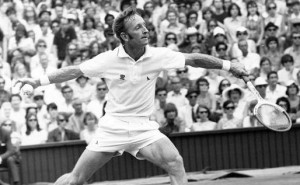Every year at the Australian Open, the name Rod Laver is front and center, not just because the Australian left-hander is regarded by many as the greatest player of all time, but because the Centre Court at Australia’s Grand Slam tournament bears his name.
His nick-name is “the Rocket” and many believe that this came from his ability to quickly run down balls and smashing them for winners. That is not the case, as Laver reveals in this exclusive book excerpt from his memoir THE EDUCATION OF A TENNIS PLAYER ($19.95, New Chapter Press, available here: http://www.amazon.com/
*****
 Though I came from Rockhampton, I moved to Brisbane and went to work for the Dunlop Sporting Goods Company when I became really serious about a career in tennis and quit school. I was fifteen.
Though I came from Rockhampton, I moved to Brisbane and went to work for the Dunlop Sporting Goods Company when I became really serious about a career in tennis and quit school. I was fifteen.
It was no country town to me. Brisbane had streetcars! Long gray things that looked like destroyers. And the lights were pretty bright for a kid off a cattle property. You didn’t take a chance on getting rained on when you went to the movies. The theater had a roof.
Charlie Hollis decided I was ready to try on metropolitan life in 1951, and Dad drove me to Brisbane for the state championship for boys fourteen and under.
“Don’t come back if you don’t win,” were Charlie’s instructions. I think Dad would have brought me back, but I got the idea. Charlie didn’t temporize. I won, and was pretty happy. Being a state champion was a very big thing to a thirteen-year-old.
The next year, Dad took me down again to attend the clinics that Harry Hopman was giving as a promotion for the newspaper, the Brisbane Courier-Mail. That made me very nervous at first. Everybody in Australia—and, I thought, the world—knew and admired Harry Hopman. He’d been a fine player, then captained the Australian Davis Cup team of Frank Sedgman and Ken McGregor that broke America’s postwar grip on the Cup in 1950. He was working with Hoad and Rosewall, who were about to burst forth as young world-beaters, and here I was, getting instruction from this important man who was respected everywhere— Wimbledon, Forest Hills, Paris, Rome.
He had a nice way with kids, though. Firm, but good-humored. He seemed to treat us as though we all had the potential of Hoad and Rosewall. He could explain everything clearly and make you work.
Charlie Hollis told Hop I was going to be a champion. I was embarrassed, but I appreciated Charlie’s testimonial, knowing well that I looked like I’d been on a hunger strike most of my life. I was short, skinny, and not too quick either.
After a couple of days, Hop remarked, “You’re the Rockhampton Rocket, aren’t you?” “Rocket” stuck.
“He was the Rocket—because he wasn’t. You know how those nicknames are,” Hop said. “Rocket was one of the slowest lads in the class. But his speed picked up as he grew stronger.”
I became determined to build up my strength; if I couldn’t grow much bigger—I weighed 143 when I finished the 1969 Grand Slam—I would at least get stronger. One of the simple things I did to build up arm strength for my wristy game was to carry an old tennis ball around and squeeze it every time I had a chance. This would help any player. One of our group at Hopman’s clinic was a good little player, Brian Littleproud, from a cattle crossing called Chinchilla out west. Sometimes I wonder what became of him. Too bad he didn’t become a champion. Wouldn’t that have been a marvelous name for the sportswriters to play with: Brian Littleproud, the cowboy from Chinchilla?
